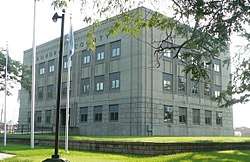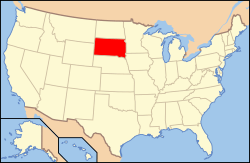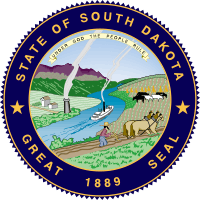Aurora County, South Dakota
| Aurora County, South Dakota | |
|---|---|
 Aurora County courthouse in Plankinton | |
 Location in the U.S. state of South Dakota | |
 South Dakota's location in the U.S. | |
| Founded | 1881 |
| Named for | Aurora, a Roman goddess |
| Seat | Plankinton |
| Largest city | Plankinton |
| Area | |
| • Total | 713 sq mi (1,847 km2) |
| • Land | 708 sq mi (1,834 km2) |
| • Water | 4.3 sq mi (11 km2), 0.6% |
| Population (est.) | |
| • (2016) | 2,736 |
| • Density | 3.8/sq mi (1.5/km2) |
| Congressional district | At-large |
| Time zone | Central: UTC−6/−5 |
Aurora County is a county located in the U.S. state of South Dakota. As of the 2010 census, the population was 2,710.[1] Its county seat is Plankinton.[2] The county was created in 1879 and organized in 1881.[3]
History
Aurora County, named for Aurora, the Roman goddess of the dawn, was created by the Dakota Territorial Legislature in 1879.[4] It was organized in 1881 when three county commissioners were appointed. The county had been established from the combination of Cragin and Wetmore Counties, which had both been formed in 1873. The county commission first met on August 29, 1881, and named Plankinton the county seat, an act which was ratified by voters in November 1882. Aurora County was reduced in size in 1883, when the northern part of the county was established as Jerauld County.[5]
Geography
According to the U.S. Census Bureau, the county has a total area of 713 square miles (1,850 km2), of which 708 square miles (1,830 km2) is land and 4.3 square miles (11 km2) (0.6%) is water.[6]
Major highways
Adjacent counties
- Jerauld County - north
- Sanborn County - northeast
- Davison County - east
- Douglas County - south
- Charles Mix County - southwest
- Brule County - west
Demographics
| Historical population | |||
|---|---|---|---|
| Census | Pop. | %± | |
| 1880 | 69 | — | |
| 1890 | 5,045 | 7,211.6% | |
| 1900 | 4,011 | −20.5% | |
| 1910 | 6,143 | 53.2% | |
| 1920 | 7,246 | 18.0% | |
| 1930 | 7,139 | −1.5% | |
| 1940 | 5,387 | −24.5% | |
| 1950 | 5,020 | −6.8% | |
| 1960 | 4,749 | −5.4% | |
| 1970 | 4,183 | −11.9% | |
| 1980 | 3,628 | −13.3% | |
| 1990 | 3,136 | −13.6% | |
| 2000 | 3,058 | −2.5% | |
| 2010 | 2,710 | −11.4% | |
| Est. 2018 | 2,738 | [7] | 1.0% |
| U.S. Decennial Census[8] 1790-1960[9] 1900-1990[10] 1990-2000[11] 2010-2016[1] | |||
2000 census
As of the census[12] of 2000, there were 3,058 people, 1,165 households, and 816 families residing in the county. The population density was 4 people per square mile (2/km²). There were 1,298 housing units at an average density of 2 per square mile (1/km²). The racial makeup of the county was 95.68% White, 0.29% Black or African American, 1.93% Native American, 0.10% Asian, 1.44% from other races, and 0.56% from two or more races. 2.09% of the population were Hispanic or Latino of any race. 48.0% were of German, 13.0% Dutch, 6.9% Norwegian, 6.6% English, 6.1% Irish and 5.8% United States or American ancestry.
There were 1,165 households out of which 29.70% had children under the age of 18 living with them, 61.30% were married couples living together, 5.00% had a female householder with no husband present, and 29.90% were non-families. 28.20% of all households were made up of individuals and 14.70% had someone living alone who was 65 years of age or older. The average household size was 2.45 and the average family size was 3.02.
In the county, the population was spread out with 27.60% under the age of 18, 6.50% from 18 to 24, 22.10% from 25 to 44, 22.20% from 45 to 64, and 21.60% who were 65 years of age or older. The median age was 41 years. For every 100 females there were 104.30 males. For every 100 females age 18 and over, there were 98.80 males.
The median income for a household in the county was $29,783, and the median income for a family was $37,227. Males had a median income of $25,786 versus $21,250 for females. The per capita income for the county was $13,887. About 7.80% of families and 11.40% of the population were below the poverty line, including 13.40% of those under age 18 and 12.00% of those age 65 or over.
2010 census
As of the 2010 United States Census, there were 2,710 people, 1,102 households, and 736 families residing in the county.[13] The population density was 3.8 inhabitants per square mile (1.5/km2). There were 1,324 housing units at an average density of 1.9 per square mile (0.73/km2).[14] The racial makeup of the county was 95.1% white, 1.5% American Indian, 0.7% Asian, 0.4% black or African American, 1.8% from other races, and 0.5% from two or more races. Those of Hispanic or Latino origin made up 3.7% of the population.[13] In terms of ancestry, 54.3% were German, 13.7% were Dutch, 11.8% were Norwegian, 8.7% were Irish, 7.2% were English, and 4.9% were American.[15]
Of the 1,102 households, 28.3% had children under the age of 18 living with them, 57.5% were married couples living together, 5.4% had a female householder with no husband present, 33.2% were non-families, and 29.9% of all households were made up of individuals. The average household size was 2.37 and the average family size was 2.96. The median age was 43.2 years.[13]
The median income for a household in the county was $45,230 and the median income for a family was $55,588. Males had a median income of $30,185 versus $27,206 for females. The per capita income for the county was $21,291. About 4.5% of families and 8.2% of the population were below the poverty line, including 7.4% of those under age 18 and 12.8% of those age 65 or over.[16]
Communities
Cities
- Plankinton (county seat)
- White Lake
Town
Census-designated places
Townships
The county is divided into twenty townships:
- Aurora Township
- Belford Township
- Bristol Township
- Center Township
- Cooper Township
- Crystal Lake Township
- Dudley Township
- Eureka Township
- Firesteel Township
- Gales Township
- Hopper Township
- Lake Township
- Palatine Township
- Patten Township
- Plankinton Township
- Pleasant Lake Township
- Pleasant Valley Township
- Truro Township
- Washington Township
- White Lake Township
Politics
Aurora County at one time favoured the Democratic Party and was one of just 130 counties nationwide to be won by South Dakota favorite son George McGovern, who grew up in adjacent Davison County. However, with the “Reagan Revolution” of the 1980s it has gradually turned into a strongly Republican county. The last Democrat to win a majority in Aurora County was Michael Dukakis during the drought- and farm crisis-affected 1988 election, and although Bill Clinton won a plurality in 1992, the county has since become as solidly Republican as most rural white counties in the US due to perceived lack of economic opportunity and differences with the Democratic Party's liberal views on social issues. Both George Bush junior in 2000 and 2004, and Donald Trump in 2016, beat the previous best GOP performance in Aurora County by substantial margins.
| Year | Republican | Democratic | Third parties |
|---|---|---|---|
| 2016 | 69.2% 974 | 24.2% 340 | 6.6% 93 |
| 2012 | 57.4% 804 | 39.7% 556 | 2.9% 40 |
| 2008 | 53.1% 794 | 43.8% 655 | 3.1% 46 |
| 2004 | 61.2% 1,009 | 37.6% 620 | 1.2% 20 |
| 2000 | 59.9% 847 | 36.3% 513 | 3.8% 53 |
| 1996 | 44.7% 709 | 41.8% 664 | 13.5% 214 |
| 1992 | 34.7% 594 | 39.7% 680 | 25.6% 438 |
| 1988 | 46.2% 856 | 53.2% 987 | 0.6% 11 |
| 1984 | 54.7% 1,029 | 44.6% 840 | 0.7% 14 |
| 1980 | 58.9% 1,251 | 33.4% 709 | 7.7% 163 |
| 1976 | 39.4% 831 | 60.2% 1,269 | 0.4% 9 |
| 1972 | 46.0% 1,075 | 53.7% 1,257 | 0.3% 7 |
| 1968 | 46.7% 1,043 | 47.5% 1,060 | 5.8% 130 |
| 1964 | 35.9% 871 | 64.1% 1,555 | |
| 1960 | 49.9% 1,267 | 50.1% 1,270 | |
| 1956 | 43.4% 1,055 | 56.6% 1,374 | |
| 1952 | 59.4% 1,458 | 40.6% 997 | |
| 1948 | 45.0% 1,056 | 54.3% 1,275 | 0.7% 16 |
| 1944 | 53.5% 1,163 | 46.5% 1,011 | |
| 1940 | 50.4% 1,408 | 49.6% 1,385 | |
| 1936 | 36.5% 1,082 | 60.8% 1,801 | 2.7% 80 |
| 1932 | 26.7% 860 | 71.6% 2,304 | 1.7% 55 |
| 1928 | 51.7% 1,552 | 47.5% 1,426 | 0.8% 23 |
| 1924 | 36.3% 967 | 25.0% 665 | 38.7% 1,031 |
| 1920 | 49.2% 1,004 | 21.8% 445 | 29.0% 592 |
| 1916 | 46.1% 735 | 49.7% 793 | 4.3% 68 |
| 1912 | 51.2% 801 | 48.8% 763 | |
| 1908 | 47.9% 686 | 48.5% 694 | 3.6% 52 |
| 1904 | 58.8% 652 | 36.7% 407 | 4.5% 50 |
| 1900 | 49.8% 503 | 48.1% 486 | 2.2% 22 |
| 1896 | 44.1% 387 | 54.6% 479 | 1.4% 12 |
| 1892 | 47.0% 461 | 21.1% 207 | 32.0% 314 |
See also
References
- 1 2 "State & County QuickFacts". United States Census Bureau. Retrieved November 26, 2013.
- ↑ "Find a County". National Association of Counties. Archived from the original on 2011-05-31. Retrieved 2011-06-07.
- ↑ "Dakota Territory, South Dakota, and North Dakota: Individual County Chronologies". Dakota Territory Atlas of Historical County Boundaries. The Newberry Library. 2006. Retrieved March 28, 2015.
- ↑ Soil Survey of Aurora County, South Dakota. U.S. Dept. of Agriculture. 1980. p. 2.
- ↑ Long, John H. (2006). "Dakota Territory, South Dakota, and North Dakota: Individual County Chronologies". Dakota Territory Atlas of Historical County Boundaries. The Newberry Library. Archived from the original on 2007-11-11. Retrieved 2008-01-31.
- ↑ "2010 Census Gazetteer Files". United States Census Bureau. August 22, 2012. Retrieved March 22, 2015.
- ↑ "Population and Housing Unit Estimates". Retrieved April 16, 2018.
- ↑ "U.S. Decennial Census". United States Census Bureau. Archived from the original on May 12, 2015. Retrieved March 22, 2015.
- ↑ "Historical Census Browser". University of Virginia Library. Retrieved March 22, 2015.
- ↑ Forstall, Richard L., ed. (March 27, 1995). "Population of Counties by Decennial Census: 1900 to 1990". United States Census Bureau. Retrieved March 22, 2015.
- ↑ "Census 2000 PHC-T-4. Ranking Tables for Counties: 1990 and 2000" (PDF). United States Census Bureau. April 2, 2001. Retrieved March 22, 2015.
- ↑ "American FactFinder". United States Census Bureau. Archived from the original on 2013-09-11. Retrieved 2011-05-14.
- 1 2 3 "DP-1 Profile of General Population and Housing Characteristics: 2010 Demographic Profile Data". United States Census Bureau. Retrieved 2016-03-11.
- ↑ "Population, Housing Units, Area, and Density: 2010 - County". United States Census Bureau. Retrieved 2016-03-11.
- ↑ "DP02 SELECTED SOCIAL CHARACTERISTICS IN THE UNITED STATES – 2006-2010 American Community Survey 5-Year Estimates". United States Census Bureau. Retrieved 2016-03-11.
- ↑ "DP03 SELECTED ECONOMIC CHARACTERISTICS – 2006-2010 American Community Survey 5-Year Estimates". United States Census Bureau. Retrieved 2016-03-11.
- ↑ Leip, David. "Dave Leip's Atlas of U.S. Presidential Elections". uselectionatlas.org. Retrieved 2018-04-13.
